英语人教版七年级下册Unit7 Section A 1a-2d教学设计
人教版七年级下册英语 Unit 7 Section A 1a-2d 教案设计

Unit 7It's raining!Section A 1a-2d 课前预习1.下雨、雨水2.多风的3.多云的4.晴朗的5.下雪、雪6.天气7.做饭8.坏的、糟的9.公园10.信息、消息11.捎个口信、传话12.他(he的宾格)13.能、可以14.回来、回原处15.回电话16.困难、难题17.玩电脑游戏18.不错19.听起来像20.在公园21.没问题典例精讲典例1How's the weather in Shanghai?上海的天气怎么样?“How's the weather...?”是用来询问天气状况的常见句式。
可以用来询问天气的常用句式还有“What's the weather like...?”和“What do you think of the weather?”等。
回答时常用代词it 来指代“天气”和“气候”。
weather意为“天气”,是个抽象的不可数名词,前面不能加不定冠词a。
典例2How's it going?一切好吗?此句话用来表达说话人对朋友、家人的问候。
it 表示目前的情况或状况,动词going 表示进展。
类似的表达还有:How is the thing going?/How are the things going?/How is everything?/How is everything going?【拓展】本句话的答语一般可用:Great!好极了!/Not bad.不错。
/Terrible!糟透了!/Pretty good.相当好。
/Fine.好。
/Quite well,thank you.很好,谢谢。
典例3Can I take a message for him?我可以给他捎个口信儿吗?message(n.)信息,消息,可数名词。
常见短语:take a message for 意为“给……捎个口信”,leave a message 意为“留言”。
人教版七年级下册英语Unit7 SectionA(1a-2d)优质教学设计(含教学反思)

Unit 7It's raining!第一课时Section A(1a-2d)Target Navigation【目标导航】Key words and phrases:rain,windy,cloudy,sunny,snow,weather,cook,bad,park,message,him,could,back,problem,take a message,call (sb.) backKey sentences:(1)—How's the weather in Shanghai?—It's cloudy.(2)—What's Uncle Joe doing?—He's playing basketball.(3)—How's it going?—Not bad,thanks.Skills:学会如何描述天气。
描述不同的天气情况下人们正在做的事情。
—What is/are … doing?—…is/are doing…—How's the weather in …?—It's …Emotion:加深同学间互相了解,促进同学间友好相处,同时激发他们对学习英语的兴趣和热情,学会向别人如何询问天气。
The guidance of learning methods【学法指导】让学生围绕着课堂任务在小组中分工合作,在活动中相互探讨、相互交流、相互合作。
Learning important and difficult points【学习重难点】1.学会如何描述天气。
2.描述不同的天气情况下人们正在做的事情。
Teaching Steps【教学过程】Autonomous Learning Scheme【自主学习方案】预习指导与检测(一)预习指导1.预习1a-2d中的生词,根据音标会读、知道汉语意思。
2.朗读1a中的生词、句型,能英汉互译。
(二)预习检测Ⅰ.汉译英。
人教版英语七年级下册Unit7 SectionA(1a-2d)名师教案
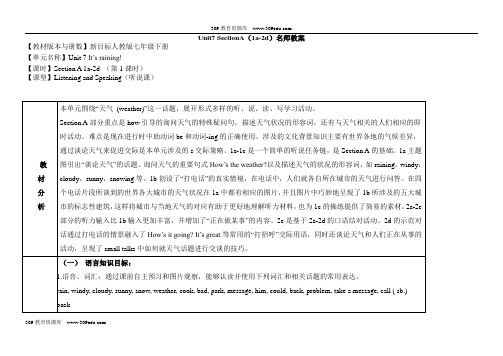
through the “IIQEE strategies”.
S: Ss prepare and review and finish something.
2.语法:
2.1能正确使用现在进行时态
A:What are you doing?
B:I’m playing basketball with some friends at the park.
A:What’s he doing?
B:He’s studying at his friend’s home.
3.听后的活动设计体现对文本内容的深度挖掘和文本再构,体现了对学生思维品格文化品格的训练与培养。
附:教学活动设计
步骤
过程
措施(教师活动与学生活动)
目的
持续性评价
1
预备与激活先期知识
Step 1
Greeting and
Leading in
( 5mins )
1.Show the goals of this lesson.
Section A部分重点是how引导的询问天气的特殊疑问句,描述天气状况的形容词,还有与天气相关的人们相应的即时活动。难点是现在进行时中助动词be和动词-ing的正确使用。涉及的文化背景知识主要有世界各地的气候差异,通过谈论天气来促进交际是本单元涉及的s交际策略。1a-1c是一个简单的听说任务链,是Section A的基础。1a主题图引出“谈论天气”的话题、询问天气的重要句式How’s the weather?以及描述天气的状况的形容词,如raining,windy,cloudy,sunny,snowing等。1b创设了“打电话”的真实情境,在电话中,人们就各自所在城市的天气进行问答。在四个电话片段所谈到的世界各大城市的天气状况在1a中都有相应的图片,并且图片中巧妙地呈现了1b所涉及的五大城市的标志性建筑,这样将城市与当地天气的对应有助于更好地理解听力材料,也为1c的操练提供了简易的素材。2a-2c部分的听力输入比1b输入更加丰富,并增加了“正在做某事”的内容。2c是基于2a-2d的口语结对活动。2d的示范对话通过打电话的情景融入了How’s it going?It’s great.等常用的“打招呼”交际用语,同时还谈论天气和人们正在从事的活动,呈现了small talks中如何就天气话题进行交谈的技巧。
人教版七年级下册英语Unit 7 教案设计

Unit 7 It's raining!Section A 第1课时(1a-1c)自主学习方案1.自学生词,并记住拼读及拼写。
2.预习课本找出重点短语及句子。
(见学案自学导练内容)3.读记后完成自学导练内容。
课堂导学方案Step1 情景导入展示给学生不同城市的天气的图片或幻灯片。
T : How' s the weather in Beijing?S: It’s cloudy/rainy/sunny/ …(根据预习来回答)教师根据学生的拼读情况纠正语音。
T :What about the weather in Shanghai?S: It's hot. /It snows.环节说明:利用当时的实际天气情况来导入句型 How's the weather ?这个句型的出发点是以实际生活引入课题,以旧知识引出新知识,符合学生的认知能力的发展。
Step 2完成教材1a-1c的任务1.观察la五个图片的不同的天气,并帮助学生描述。
(2分钟)2.教师领读la中的单词,学生识记并且将单词和图片中的天气情况相匹配。
(3分钟)3.学生朗读并熟记图片中的对话。
(3分钟)4.读城市的名字,然后认真听录音,将城市的名字填在图片中的方框里,完成课本上lb的听力任务。
(3分钟)5.再听一遍录音,并跟读,模仿语音语调。
(2分钟)6.仿照lc中的对话,两人一组来谈论五个城市的天气情况,并邀请一些小组表演对话。
(5分钟)参考案例:A: How's the weather in Beijing?B: It's sunny.7.小结训练(5分钟)(1)— C the weather today?—It's sunny.A. When'sB. What'sC. How's(2)— How's the weather?`—It's C .A. windB. sunC. cloudy(3)It's sunny here.(对划线部分提问)How's the weather there?What's the weather like there?环节说明:听说结合,第一时间向学生传达语言目标,通过结对对话练习和小结训练,语言目标得以强化。
人教版七年级英语下册第七单元教案 (3)

情感
目标
本课内容贴近生活,通过教学,让学生学会关心日常生活实际情况,热爱生活;
教学重点
1)掌握本课词汇:again
2)掌握并会运用下列句型:
—How'stheweather?—It'ssunny/windy/raining/snowing...—How'sitgoing?—It'sgreat/prettygood/terrible/notbad.
He'splayingbasketball.She'sbusyrightnow.
She'sonlywatchingTV.She'sjustplayingcomputergames.
2.课本2cRoleplayaconversationbetweenJimandLinda.
小组合作活动,并由个别组表演,对表现好的表扬。
利用“Whatareyoudoing?"引出新单词“doing,playing,studying,talking,making".
注意引导学生积极动脑看画,分清动词书写形式和用法的不冋;以及参考它的文化背景,学生两人一组看图对话练习。
Answers:amdoing,do,isplaying,does,Is,studying,isstudying,
W.实践应用
1•活动2d
理解对话大意,进而了解对话细节,请同学们回答下列问题:
1)Howistheweather?
2)What‘sStevendoing?
3)What'sRick'smotherdoing?
人教部编版七年级下册英语教案 Unit 7 Section A(1a-2d)导学案
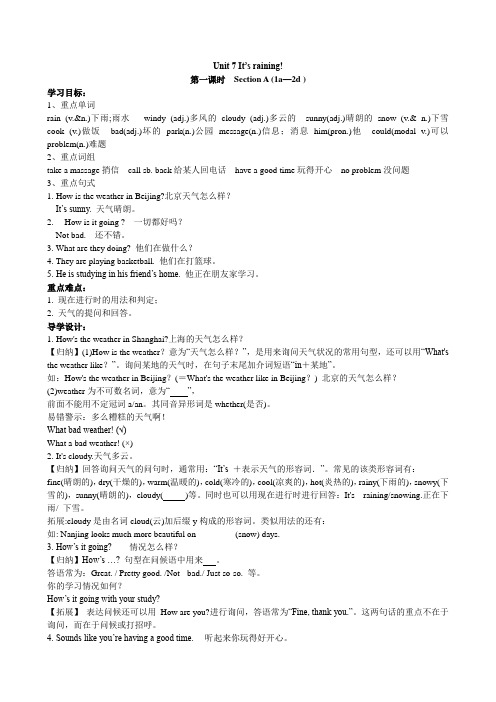
Unit 7 It’s raining!第一课时Section A (1a—2d )学习目标:1、重点单词rain (v.&n.)下雨;雨水windy (adj.)多风的cloudy (adj.)多云的sunny(adj.)晴朗的snow (v.& n.)下雪cook (v.)做饭bad(adj.)坏的park(n.)公园message(n.)信息;消息him(pron.)他could(modal v.)可以problem(n.)难题2、重点词组take a massage捎信call sb. back给某人回电话have a good time玩得开心no problem没问题3、重点句式1. How is the weather in Beijing?北京天气怎么样?---It’s sunny. 天气晴朗。
2. ---How is it going ? 一切都好吗?---Not bad. 还不错。
3. What are they doing? 他们在做什么?4. They are playing basketball. 他们在打篮球。
5. He is studying in his friend’s home. 他正在朋友家学习。
重点难点:1. 现在进行时的用法和判定;2. 天气的提问和回答。
导学设计:1. How's the weather in Shanghai?上海的天气怎么样?【归纳】(1)How is the weather?意为“天气怎么样?”,是用来询问天气状况的常用句型,还可以用“What's the weather like?”。
询问某地的天气时,在句子末尾加介词短语“in+某地”。
如:How's the weather in Beijing?(=What's the weather like in Beijing?) 北京的天气怎么样?(2)weather为不可数名词,意为“”,前面不能用不定冠词a/an。
人教新目标七年级英语下册Unit7It’sraining!SectionA(1a—2d)教学设计

4.家长协助孩子关注天气预报,让孩子尝试用英语描述当天或近期的天气情况,并分享给家人。
5. �搜索并了解至少两种课外活动,用英文介绍活动内容、地点等,下节课与同学分享。
作业要求:
1.学生需认真对待作业,按时完成,确保作业质量。
1.学生已具备一定的英语基础知识,能够理解和使用简单的英语进行日常交流,但词汇量和语法知识尚需进一步拓展。
2.学生在上一册教材中已学习过一般现在时态,但对于其在实际语境中的应用仍需加强练习。
3.学生对于天气话题较为熟悉,但在描述天气状况时,可能存在一定的语言表达困难。
4.学生在听力方面,对于速度较快的对话和较长篇幅的材料理解能力有限,需要通过有针对性的训练提高。
三、教学重难点和教学设想
(一)教学重难点
1.词汇和短语:本节课的核心词汇和短语是教学的重点,如raining,sunny,cloudy,windy,weather等。学生需要熟练掌握这些词汇,并能运用到描述天气和活动的语境中。
重难点突破设想:通过图片展示、情景模拟、小组互动等多种形式,让学生在实际语境中反复练习,加深记忆。
5.学生的学习兴趣和动机存在差异,部分学生对英语学习较为积极,而部分学生可能存在一定的学习困难。
6.学生在团队合作方面,部分学生表现出较强的沟通能力和协作精神,但也有部分学生需要加强这方面的培养。
因此,在教学过程中,教师应关注学生的个体差异,充分利用学生已有的知识背景,创设贴近学生生活的教学情境,激发学生的学习兴趣。同时,针对学生的不同需求,设计分层教学活动,使每个学生都能在原有基础上得到提高。
2.学生观看视频后,教师邀请几名学生分享自己了解到的天气信息,激发学生对新课的兴趣。
人教新目标英语七年级下册Unit 7 Section A (1a-2d)教案设计
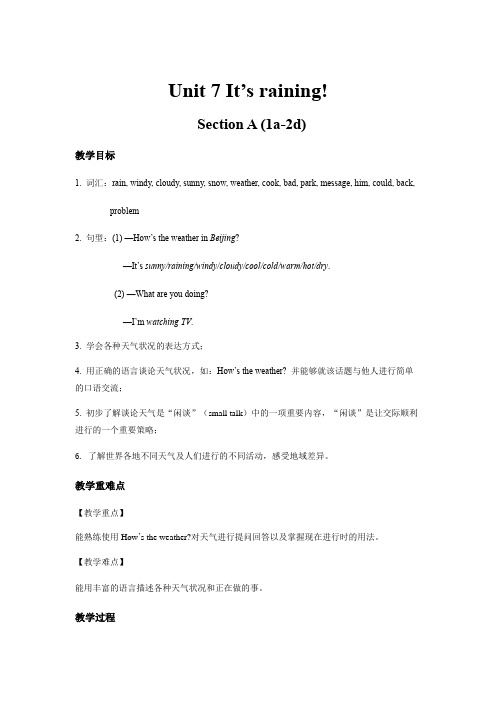
Unit 7 It’s raining!Section A (1a-2d)教学目标1. 词汇:rain, windy, cloudy, sunny, snow, weather, cook, bad, park, message, him, could, back,problem2. 句型:(1) —How’s the weather in Beijing?—It’s sunny/raining/windy/cloudy/cool/cold/warm/hot/dry.(2) —What are you doing?—I’m watching TV.3. 学会各种天气状况的表达方式;4. 用正确的语言谈论天气状况,如:How’s the weather? 并能够就该话题与他人进行简单的口语交流;5. 初步了解谈论天气是“闲谈”(small talk)中的一项重要内容,“闲谈”是让交际顺利进行的一个重要策略;6. 了解世界各地不同天气及人们进行的不同活动,感受地域差异。
教学重难点【教学重点】能熟练使用How’s the weather?对天气进行提问回答以及掌握现在进行时的用法。
【教学难点】能用丰富的语言描述各种天气状况和正在做的事。
教学过程Task 1Step 1. Warm-up1. Watch a cartoon How’s the weather in Beijing?2. Ss talk about the weather in the cartoon.(设计意图:通过呈现妈妈和男孩分别在两个不同城市,通过打电话谈论有关天气和人物正在做的事情的动画,引出本单元话题,激发学生对新课探究的欲望,增强学习兴趣。
) Step 2. Pre-listening (1a)1. Look at the pictures and talk about the weather. Learn the new words and expressions. Then help students learn how to describe the weather.(设计意图:呈现有关天气的图片,引导学生运用重要句式How’s the weather?结合图片内容进行提问与回答,帮助学生初步感知有关天气问答的语言表达。
初中英语七年级下册 Unit7. SectionA(1a-2d)说课稿
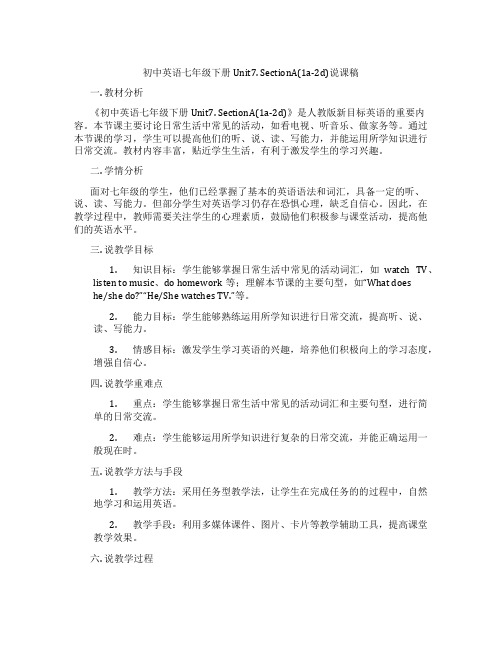
初中英语七年级下册 Unit7. SectionA(1a-2d)说课稿一. 教材分析《初中英语七年级下册Unit7. SectionA(1a-2d)》是人教版新目标英语的重要内容。
本节课主要讨论日常生活中常见的活动,如看电视、听音乐、做家务等。
通过本节课的学习,学生可以提高他们的听、说、读、写能力,并能运用所学知识进行日常交流。
教材内容丰富,贴近学生生活,有利于激发学生的学习兴趣。
二. 学情分析面对七年级的学生,他们已经掌握了基本的英语语法和词汇,具备一定的听、说、读、写能力。
但部分学生对英语学习仍存在恐惧心理,缺乏自信心。
因此,在教学过程中,教师需要关注学生的心理素质,鼓励他们积极参与课堂活动,提高他们的英语水平。
三. 说教学目标1.知识目标:学生能够掌握日常生活中常见的活动词汇,如watch TV、listen to music、do homework等;理解本节课的主要句型,如“What doeshe/she do?”“He/She watches TV.”等。
2.能力目标:学生能够熟练运用所学知识进行日常交流,提高听、说、读、写能力。
3.情感目标:激发学生学习英语的兴趣,培养他们积极向上的学习态度,增强自信心。
四. 说教学重难点1.重点:学生能够掌握日常生活中常见的活动词汇和主要句型,进行简单的日常交流。
2.难点:学生能够运用所学知识进行复杂的日常交流,并能正确运用一般现在时。
五. 说教学方法与手段1.教学方法:采用任务型教学法,让学生在完成任务的的过程中,自然地学习和运用英语。
2.教学手段:利用多媒体课件、图片、卡片等教学辅助工具,提高课堂教学效果。
六. 说教学过程1.导入:教师通过提问学生日常生活中喜欢的活动,激发学生的学习兴趣,引入新课。
2.呈现:教师展示与本节课相关的图片和卡片,引导学生说出相应的活动词汇和句型。
3.Practice: 学生分组进行角色扮演,运用所学知识进行日常交流。
【人教版新目标】初一七年级英语下册《Unit 7》单元教案
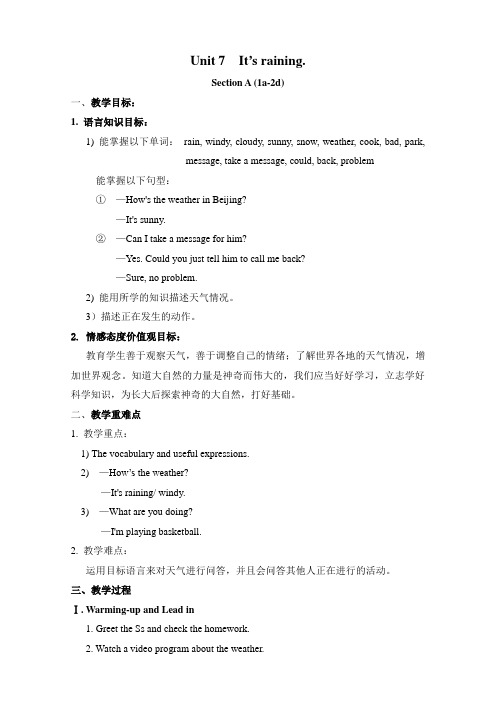
Unit 7 It’s raining.Section A (1a-2d)一、教学目标:1. 语言知识目标:1) 能掌握以下单词:rain, windy, cloudy, sunny, snow, weather, cook, bad, park,message, take a message, could, back, problem 能掌握以下句型:①—How's the weather in Beijing?—It's sunny.②—Can I take a message for him?—Yes. Could you just tell him to call me back?—Sure, no problem.2) 能用所学的知识描述天气情况。
3)描述正在发生的动作。
2. 情感态度价值观目标:教育学生善于观察天气,善于调整自己的情绪;了解世界各地的天气情况,增加世界观念。
知道大自然的力量是神奇而伟大的,我们应当好好学习,立志学好科学知识,为长大后探索神奇的大自然,打好基础。
二、教学重难点1. 教学重点:1) The vocabulary and useful expressions.2) —How’s the weather?—It's raining/ windy.3) —What are you doing?—I'm playing basketball.2. 教学难点:运用目标语言来对天气进行问答,并且会问答其他人正在进行的活动。
三、教学过程Ⅰ. Warming-up and Lead in1. Greet the Ss and check the homework.2. Watch a video program about the weather.Ⅱ. Presentation1. (Show some pictures of the weather)Let Ss look at the pictures and ask them how the weather is.Ss learn the new words and expressions with the help of the pictures.2. Look at the pictures in 1a. Then read the new words on the right. Ask the Ss tomatch the words with pictures.3. Check the answers.Ⅲ. Game (How's the weather?)1. (Showing some pictures on the big screen.) Ask Ss "How's the weather?"2. Ss guess and answer the question.Ⅳ. Listening1. Now let's look at the city names in the box in 1b. Please read after me.Ss read the cities after the teacher.2. Now, We’ll hear four conversations. Listen carefully, point out each city in thepicture as it comes upon the tape. Play the recording a second time. Ask Ss to write the name of the city in the picture of its weather.3. Check the answers.Ⅴ. Pair work1.Tell the Ss: If you are in one of the places in the picture above. Talk about theweather with your friends in another city on the phone.2. Make a model with a student like this:T: Hi! How's the weather in Beijing?S1: It's sunny.3. Ss work in pairs. Ask and answer about the weather in the cities.Ⅵ. Listening1. Work on 2a.Let's see what Joe's families are doing. Point to the 4 pictures.2. Ask Ss tell each person is doing in each picture. More attentions should be paidto the correct use of the Present Progressive Tense.3. Play the recording for the Ss to listen and number the pictures [1-4].4. Play the tape for Ss to check the answers.5. With the whole picture, get some Ss to tell the story of it.6. BrainstormingPlay the tape for another time. Then do a memory test.Ask Ss: What's Uncle Joe/Jeff/Mary/Aunt Sarah doing?What're Scott and Lucy doing?Is Jeff watching TV? etc.7. Let Ss match the names with the activities in 2b.Play the recording for the Ss to check the answers.Ⅶ. Pair work1. Look at the pictures and talk about the people in 2a with a partner.2. Ask a student the questions as a model:T: What's Uncle Joe doing?S1: He's playing basketball.3. Ss work in pairs. Ask and answer about the pictures.Ⅷ. Role-play1. Ask Ss to read the conversation and answer the questions:①What's Steve doing?②What's Rick's brother doing?Ss read the conversations and answer the questions. Then check the answers together.2. Let Ss role-play the conversation in pairs.IX. Language points.X. ExercisesHomework:一、总结有关天气的词汇。
人教版七下Unit 7 Section A (1a-2c)课程教学设计
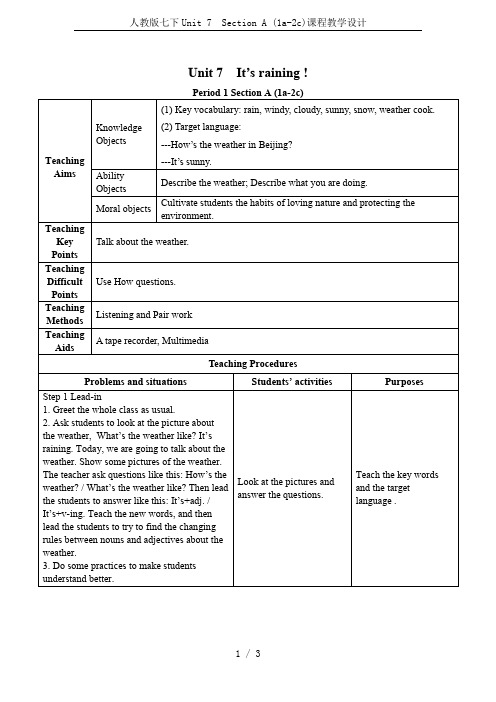
---It’s sunny.
Ability Objects
Describe the weather; Describe what you are doing.
Moral objects
Cultivate students the habits of loving nature and protecting the environment.
Finish 2c.
Improve the students’cooperation and communication abilities.
Step 6 Summary
1. Letthestudents know what they have learnedthis lesson.
2. Check the guidance cases.
3. Tell students: If you are in one of the places in 1a, talk about the weather with your friends on the phone. Finally, invite some pairs to act out.
Teaching Procedures
Problems and situations
Students’ activities
Purposes
Step 1 Lead-in
1. Greet the whole class as usual.
2.Ask students tolook at the picture about the weather,What’s the weather like? It’s raining. Today, we aregoing to talk about the weather. Show some picturesof the weather. The teacherask questions like this: How’s the weather? / What’s the weather like? Then lead the studentstoanswer like this: It’s+adj. / It’s+v-ing. Teach the new words, and then leadthestudents to try to find the changing rules between nouns and adjectives about the weather.
人教版七下英语Unit7第1课时(SectionA 1a-2d)

2. It’s raining! 天在下雨!(教材P37 标题) rain /reɪn/ v. 下雨 n. 雨水 (1) rain在此作动词,意为“下雨”,raining是其动词-ing 形式。 ➢ It often rains in summer. 夏天经常下雨。 ➢ It’s raining in Guangzhou. 广州正在下雨。 (2) rain还可作不可数名词,意为“雨水”。the rains表 示“雨季”。 ➢ There is a lot of rain here every year。这里每年雨水都很多。
Language point Aunt Sally is cooking. 萨莉婶婶在做饭。 (教材P38 2b) cook /kʊk/ v. 做饭
cook在此作不及物动词,意为“做饭”。 ➢ My grandma is cooking. 我奶奶正在做饭。 【拓展】(1) cook还可作及物动词,意为“烹饪”,其后 可接双宾语,cook sb. sth. = cook sth. for sb., 意为“为某人 做……(饭)”。
Unit 7 It’s raining!
Section A 1a-2d
初中英语 七年级下册 RJ
Learning goals
1. New words: weather, rain, windy, cloudy, sunny, snow, cook, bad, park, message, him, could, back, problem
Uncle Joe is __p_la_y_in__g_ __b_a_s_k_e_tb_a_l_l _ .
2a Listen and number the pictures [1-4].
人教版英语七年级下册Unit7sectionA1a2d教学设计
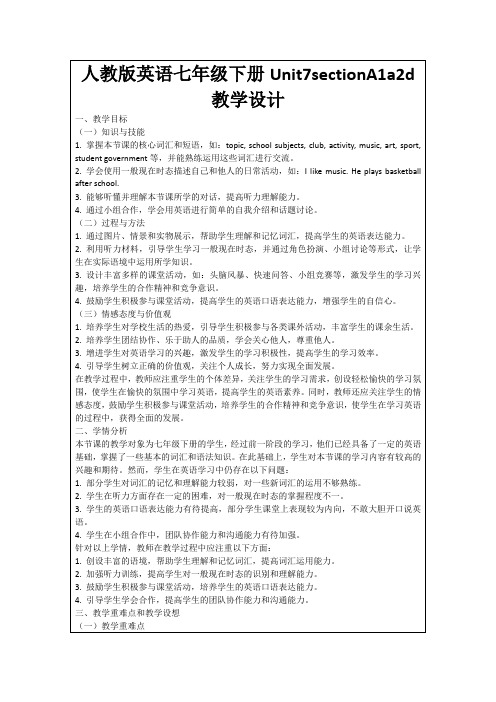
4.教师应及时检查作业,给予反馈,指导学生纠正错误,提高学习效果。
5.家长的参与和支持有助于提高学生的学习积极性,教师应与家长保持沟通,共同关注学生的成长。
3.针对听力训练,选取与学生生活密切相关的听力材料,提高学生的兴趣和听力理解能力。同时,注重听力策略的指导,如预测、关键词定位等,帮助学生更好地捕捉信息。
4.对于教学难点,采用分步骤、循序渐进的方法进行教学。首先,通过示例句型,让学生模仿和练习;其次,设计各种练习题,让学生在实际操作中巩固知识;最后,组织小组活动,让学生在互动交流中提高运用能力。
2.学会使用一般现在时态描述自己和他人的日常活动,如:I like music. He plays basketball after school.
3.能够听懂并理解本节课所学的对话,提高听力理解能力。
4.通过小组合作,学会用英语进行简单的自我介绍和话题讨论。
(二)过程与方法
1.通过图片、情景和实物展示,帮助学生理解和记忆词汇,提高学生的英语表达能力。
二、学情分析
本节课的教学对象为七年级下册的学生,经过前一阶段的学习,他们已经具备了一定的英语基础,掌握了一些基本的词汇和语法知识。在此基础上,学生对本节课的学习内容有较高的兴趣和期待。然而,学生在英语学习中仍存在以下问题:
1.部分学生对词汇的记忆和理解能力较弱,对一些新词汇的运用不够熟练。
2.学生在听力方面存在一定的困难,对一般现在时态的掌握程度不一。
6.鼓励学生利用网络资源,观看英语短视频,学习与学校生活相关的词汇和表达,拓宽知识面。
7.教师推荐一本适合七年级学生的英语读物,要求学生阅读并摘录与学校生活相关的词汇和句子,进行积累和分享。
七年级英语下册教学(人教版,河北专版)Unit7SectionA(1a2d)教学设计
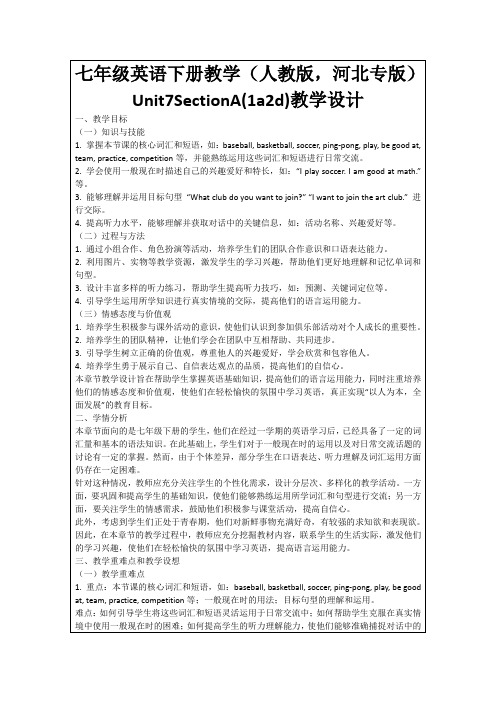
此外,考虑到学生们正处于青春期,他们对新鲜事物充满好奇,有较强的求知欲和表现欲。因此,在本章节的教学过程中,教师应充分挖掘教材内容,联系学生的生活实际,激发他们的学习兴趣,使他们在轻松愉快的氛围中学习英语,提高语言运用能力。
2.重点:培养学生的团队合作意识和口语表达能力。
难点:如何在课堂活动中充分调动学生的积极性,使他们主动参与并投入到小组合作和角色扮演中。
(二)教学设想
1.利用多媒体教学资源,如图片、实物等,帮助学生形象地记忆和理解词汇和句型。同时,设计丰富多样的练习,如填空、选择、改错等,巩固学生对知识点的掌握。
2.创设真实情境,让学生在角色扮演、小组讨论等活动中,运用所学知识进行交际。教师在此过程中要关注学生的语言运用,及时给予指导和反馈。
2.教师通过实例讲解一般现在时的用法,帮助学生掌握该时态在描述兴趣爱好和特长时的运用。
3.教师呈现目标句型“What club do you want to join?” “I want to join the art club.”,引导学生学习和运用。
(三)学生小组讨论
1.教师将学生分成小组,让他们讨论以下问题:“What are your hobbies? Which club do you want to join? Why?”
(三)情感态度与价值观
1.培养学生积极参与课外活动的意识,使他们认识到参加俱乐部活动对个人成长的重要性。
2.培养学生的团队精神,让他们学会在团队中互相帮助、共同进步。
【人教版七年级英语下册教案】Unit7SectionA(1a~2d)

Unit 7 It's raining!Section A (1a~2d)教课目标【知与技术】1. 掌握句型: (1) — How's the weather in Beijing?—It's sunny.(2)—Can I take a message for him?—Yes. Could you just tell him to call me back?—Sure, no problem.2.掌握本及短: rain, windy, cloudy, sunny, snow, weather, cook, bad, park, message, take a message, could, back, problem3. 掌握以下法:在行的用法【程与方法】教携四时化的片或播放一段各种天气化的,一 : It is snowing in winter in our city .⋯等与学生睁开自由,学生相互各地四时的化,引出本的,通状况来提升学生的主性。
【感情、度与价】教育学生擅长察天气,擅长整自己的情;认识世界各地的天气状况,增添世界念。
知道大自然的力量是奇异而大的,我当好勤学,奋发学好科学知,大后探究奇异的大自然,打好基。
教课重难点【教课要点】(1)the vocabulary and useful expressions ;(2)—How’ s the weather?—It's raining/ windy.(3) — What are you doing?—I'm playing basketball.【教课点】运用目言来天气行答,而且会答其余人正在行的活。
教课准备片、多媒体等教课过程Step 1 Warming-up and Lead in1.Greet the Ss and check the homework.2.Watch a video program about the weather.Step 2 Presentation1. (Show some pictures of the weather)Let Ss look at the pictures and ask them how the weather is.Ss learn the new words and expressions with the help of the pictures.2.Look at the pictures in 1a. Then read the new words on the right. Ask the Ss to match thewords with pictures.3.Check the answers.Step 3 Game (How's the weather?)1.(Showing some pictures on the big screen.) Ask Ss "How's the weather?"2.Ss guess and answer the question.Step 4 Listening1.Now let's look at the city names in the box in 1b. Please read after me.Ss read the cities after the teacher.2.Now, We’ ll hear four conversations. Listen carefully, point out each city in the picture as it comes upon the tape. Play the recording a second time. Ask Ss to write the name of the city inthe picture of its weather.3. Check the answers.Step 5 Pair work1.Tell the Ss: If you are in one of the places in the picture above. Talk about the weather with your friends in another city on the phone.2.Make a model with a student like this:T:Hi! How's the weather in Beijing?S1: It's sunny.3. Ss work in pairs. Ask and answer about the weather in the cities.Step 6 Listening1. Work on 2a.Let's see what Joe's families are doing. Point to the 4 pictures.2.Ask Ss tell each person is doing in each picture. More attentions should bepaid to the correct use of the Present Progressive Tense.3.Play the recording for the Ss to listen and number the pictures [1-4].4.Play the tape for Ss to check the answers.5.With the whole picture, get some Ss to tell the story of it.6.BrainstormingPlay the tape for another time. Then do a memory test.Ask Ss: What's Uncle Joe/Jeff/Mary/Aunt Sarah doing?What're Scott and Lucy doing?Is Jeff watching TV?etc.7. Let Ss match the names with the activities in 2b.Play the recording for the Ss to check the answers.Step 7 Pair work1.Look at the pictures and talk about the people in 2a with a partner.2.Ask a student the questions as a model:T:What's Uncle Joe doing?S1: He's playing basketball.3. Ss work in pairs. Ask and answer about the pictures.Step 8 Role play the conversation课堂作业一、总结有关天气的词汇。
初中英语人教版七年级下册Unit 7 Section A 教学设计

Unit 7 It’s raining! Section A (1a-1c)教学设计昌江黎族自治县红林学校黄小欢I.教学分析本课是七年级下册英语第七单元Section A (1a-1c)的教学内容。
主要围绕“天气”进行教学,能够运用What’s the weather like like?与How’s the weather?进行问答,学会表达天气It’s windy/rainy/raining等句型。
II.学情分析本届学生我担任的是七(2)与七(3)班,共有学生72人,其中男生39人,女生33人。
大多数学生学习积极性不高,学习目的性不明确,上课不认真听课,开小差,报着混日子的态度来校,属厌学与弃学状态。
小部分学生想学好英语,但是由于记忆能力不强,原来滚瓜烂熟的东西,一段时间就忘了,因此学习成绩不是很理想。
只有四名学生的基础知识较牢固,对英语的学习兴趣较浓厚,学习目的性明确。
III.教学设计1.学习理解词汇windy, rain, cloudy, sunny, snow, weather。
2.学会使用句型:How’s the weather in Shanghai?It’s cloudy.3.能够用所学的词汇表达天气:It’s raining.. / It’s rainy.IV.教学重难点1.句型:How’s the weather in Shanghai?=What’s the weather like in Shanghai?2.表达天气的词汇:rain →rainy cloud →cloudysnow →nowy wind →windysun →sunnyV.教学方法在本课教学过程中,在注重启发引导,培养学生分析、概括能力的同时,更要注重教学方法的灵活性,通过任务型教学法、情景交际法等,让学生乐于接受,易于接受。
VI.教学准备录音机,磁带,图片;多媒体教学VII.教学过程Step 1 : Greetings and leading inT: Good morning,everyone!Ss: Good morning,Miss Huang.T: How are you today?Ss:Fine,thanks. And you?T: I’m fine,,too. I feel good today. Because it’s a fine day. What’s the weather like today?(T points to the sky.)Ss:Sunny.T: Good! It’s sunny today. And I feel hot now.(do an action) Look!(show a flash) It’s raining. …(repeat this sentence)How’s the weather now?Ss: It’s raining.T: Good ! It’s raining.(write down on the blackboard) Today we’ll learn Unit7.Please turn to page 37.(point to the page) Then ask the students read the title with the teacher a few times.Step 2 : Practice1.Teach the new words “rain,cloudy,sunny,windy,snow,weather”by the flashes.2.Practice reading the new words.(the teacher walk through the room.)3.Brainstorm.Divide the student into two group to say out the words as quickly as possible.One will get one point for each group.4.Match the pictures with the words in 1a,then check the answers.5.Listen to the tape,and write down the city names in the boxes.Then check the answers.6.Look at the tapescripts of this listening practice,ask the students to read after the tape.Step 3: Consolidation1.Pair work.Practice the dialogs in pairs.Then role play the dialog.2.Look at the pictures about weather of some places,and ask and answer like this:A:How’s the weather in ______?B:It’s_______.3.Written workWrite down two dialogs about the pictures they like.eg. A:How’s the weather in Chengdu?B:It’s windy.4.Fill in the blanks.一、根据提示完成对话。
- 1、下载文档前请自行甄别文档内容的完整性,平台不提供额外的编辑、内容补充、找答案等附加服务。
- 2、"仅部分预览"的文档,不可在线预览部分如存在完整性等问题,可反馈申请退款(可完整预览的文档不适用该条件!)。
- 3、如文档侵犯您的权益,请联系客服反馈,我们会尽快为您处理(人工客服工作时间:9:00-18:30)。
Unit 7 It’s raining!一、教学背景这一单元的中心话题是Describe the weather。
语法现象是Present Progressive Tense。
继Unit6 I’m watching TV第二次出现了现在进行时态,是上一单元的延续。
比较上一单元,本单元增设了一个日常生活中重要的情景Talking about the weather 。
学生不但要具备并熟练地掌握现在进行时态的意识和技巧,并且要会运用这一时态描述在各种天气背景下人的活动。
二、教材内容本单元语言训练的重点是(1)谈论天气;(2)描述正在发生的动作。
重点语言结构是(1)How引导的特殊疑问句;(2)Yes/No问句及答语;(3)现在进行时的用法。
Section A主要是听读说和基础语言运用,为目标句型提供分步示例和指导性练习;Section B知识扩展、新旧知识的运用,循序渐进的写作练习;运用所学的语言完成各种任务使学生能够对已经学过的目标句型运用自如:Self -Check自我评价,词汇知识的评价,语言应用能力的评价。
三、单元总体学习目标1、词汇基础核心词汇:sunny, cloudy, snowing, raining, windy, cold, hot, cool, warm, humid,terrible掌握:rain, snow, weather, cook, study, bad, pretty, lying, beach, group, surprised, beat, relaxed, winter, scarf, everyone, man, like了解:Moscow, Bo ston, how’s=how is, vocation, beach, volleyball补充词汇:spring, summer, autumn, sandstorm, typhoon, tsunami(海啸)2、语法(1)现在进行时(2) 有关天气的特殊问句及答语3、日常交际用语4、语言技能1)能用英语打招呼和描述并谈论不同的天气。
2)能用现在进行时互相交流。
3)能用现在进行时叙述在不同地方的和不同的天气背景下人们能做的事。
5、情感态度1)通过课文教学引导学生关注天气情况,爱护环境,保护大气等自然资源的良好意识。
2)通过学习打招呼、谈论天气和所做的事时所用的交际用语,学会与人友好相处。
3)通过学习和对比不同天气背景下人的活动,激发学生的内在情感,进行爱的教育。
4)能在小组活动中积极与他人合作,相到帮助,共同完成学习任务。
6、文化意识了解不同地方和不同的天气背景下人们能做的事,互相交流不同国家的文化,对学生进行不同文化意识的渗透。
同时让了解其他国家风景,风俗,增加学生的背景知识,增强学科间的交流。
培养学生具有一定的环保意识、责任意识和关爱他人之心。
7、学习策略通过任务型的教学,让学生学会自主学习,归纳总结,培养主动学习的能力。
尤其对所学内容能主动复习并加以整理和归纳的能力。
四、教学设计Period OneSection A 1a-2dⅠ. Teaching aims1. Knowledge①Words:rain,windy,cloudy,sunny,snow,weather,Moscow,Boston,how’s,bad,terrinle,pretty,cool, cold, humid, warm, hot②Sentence structures: How’s it going? How’s the weather? What’s the weather like?2. Ability: Talk about the weather and greet each other with a new structure.3. Cultural awareness: A new way of greetings and asking about the weather is quite a common greeting in western countries.ⅡImportant points: A new way of greetings and the description words about the weather.Ⅲ.Difficult points: How’s the weather? It’s raining/windy/cloudy/sunny/snowing/.How’s it going? Great! /Not bad! /Terrible! /Pretty good!ⅥTeaching proceduresStep1. Warming up1. As k the Ss randomly: What’s the date today? What day is it today? How are you?2. Give a new expression which has the same meaning as How are you? : How’s it going? But the new one has more answers.Step2. Presentation1. Show 4 faces on the screen and ask Ss to describe each face using whatever words they can. Help Ss identify each person is feeling.2. Then show 4 words. Say the words and ask Ss to repeat each one. Ask Ss to match each remembered phrase with a face. Encourage them to spell the phrases by How do you spell it?3. Practice with the new structure by the whole class: Choose one to the front and the others guess the description words through his/her facial expressions.Step3. Presentation1. Let one student ask me: How’s it going? I may answer like this: Terrible! Because it’s snowing and it’s so cold. Show a picture of snowing day and children are making a snowman and pretend to be very cold. Make Ss guess the words: the weather and snowing. Ask them: How’s the weather? Get them to answer like: It’s snowing/snowy. Go on with other kinds of weather: sunny, rainy, cloudy, windy.2. Point out the numbered list of description words. Say each one and ask Ss to repeat the words again. Then ask Ss to match each word with one of cities in the picture. Check the answers.3. Play the tape and get Ss to write the city names in the boxes. Check the answers. Look at the 5 pictures in 1a. Encourage Ss to use the description words to describe the weather: ①Beijing—sunny and warm/hot ②Shanghai—cloudy and cool ③Boston—windy and cool ④Moscow—snowing and cold ⑤Toronto—raining and humid. Show an arrow to identify the degree of the 4 adjectives: cold, cool, warm and hot.4. Practice with the structures: How’s the weather? and What’s the weather like? with the 5pictures The exact weather on that day should not be missed. Note: Talking about the weather is quite common in western countries as a daily greeting.Step4. Weather reportShow a weather map of China. Get Ss to make a weather report as a CCTV anchor. They may begin with asking the weather in each city, then make up a report about it.Step5. ChantShow an easy chant to reinforce the questions and words about the weather.Step6. Homework1. Copy the new words 4 times each.2. Summarize the usages of how in questions.3. Watch a weather report on TV and take down some notes about the weather forecast for tomorrow, and then write a report about it.。
